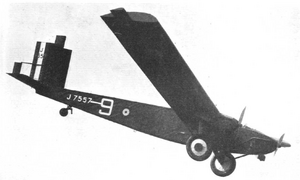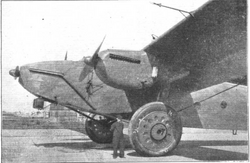Engineering:Beardmore Inflexible
| Inflexible | |
|---|---|

| |
| Role | Experimental Transport |
| Manufacturer | Beardmore |
| Designer | Dr Rohrbach[1]/W.S Shackleton |
| First flight | 5 March 1928 |
| Introduction | 1928 |
| Retired | 1930 |
| Status | Retired |
| Primary user | Royal Air Force |
| Number built | 1 |
The Beardmore Inflexible, also known as the Rohrbach Ro VI, was a three-engined all-metal prototype transport aircraft built by William Beardmore and Company at Dalmuir, Scotland.
Design and development
William Beardmore and Company had acquired a licence for the use of the Rohrbach principle for stressed-skin construction. Using these principles and drawings supplied by Rohrbach for the RoVI, the Beardmore company built a massive all-metal three-engined transport, the Beardmore Inflexible.
The aircraft was built in sections at Dalmuir between 1925 and 1927 which were shipped by sea to Felixstowe and from there delivered by road to the Aeroplane & Armament Experimental Establishment (A&AEE) at Martlesham Heath Airfield where it first flew on 5 March 1928.[2] It appeared at the Hendon RAF Display later in the year. The aircraft was structurally advanced for its time and had good flying qualities. It was also a very large aircraft for the time, having a wingspan of 157 ft (48 m) - around 16 ft (4.9 m) greater than the Boeing B-29 Superfortress heavy bomber of World War II. However, with an all up weight of 37,000 lb (17,000 kg) it was underpowered and, with no interest forthcoming from the RAF for a production contract, the aircraft was dismantled at Martlesham Heath in 1930. It was then examined for the effects of corrosion on light-alloy stressed skin structures.
One of the aircraft's wheels survives, and is on exhibit in the Science Museum, London.
Operators
 United Kingdom
United Kingdom
Specifications
Data from Air Enthusiast International [2]
General characteristics
- Length: 75 ft 6 in (23.01 m)
- Wingspan: 157 ft 6 in (48.01 m)
- Height: 21 ft 2 in (6.45 m)
- Wing area: 1,967 sq ft (182.7 m2)
- Empty weight: 24,301 lb (11,023 kg)
- Max takeoff weight: 37,000 lb (16,783 kg)
- Powerplant: 3 × Rolls-Royce Condor II V12 piston engine, 650 hp (480 kW) each
Performance
- Maximum speed: 109 mph (175 km/h, 95 kn)
- Service ceiling: 9,350 ft (2,850 m) [3]
- Rate of climb: 436 ft/min (2.21 m/s) at 2,000 ft (610 m)[3]
See also
Related development
Aircraft of comparable role, configuration and era
Related lists
- List of aircraft of the Royal Air Force
References
Notes
Bibliography
- "The Beardmore Inflexible". Flight: 225–226. 5 April 1928. http://www.flightglobal.com/pdfarchive/view/1928/1928%20-%200253.html.
- The Illustrated Encyclopedia of Aircraft (Part Work 1982-1985). Orbis Publishing.
- Jackson, A. J. (1973). British Civil Aircraft since 1919. 1. London: Putnam. ISBN 978-0370100067.
- Jarrett, Philip (March 1990). "Beardmore’s heavy metal monsters – Part 2". Aeroplane Monthly 18 (3): 136–142. ISSN 0143-7240.
- "Plane Facts". Air Enthusiast International (Bromley, UK: Fine Scroll) 6 (3): 145. March 1974.
- Taylor, Michael J. H. (1989). Jane's Encyclopedia of Aviation. London: Studio Editions. p. 123. ISBN 978-0517103166.
External links
- Film clip of the Inflexible taxiing and taking off at the Norwich Air Display, May 1929; Pathé News online archive.
 |


